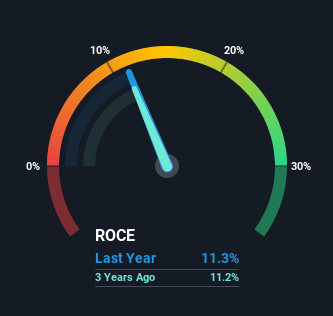[ad_1]
If we want to find a potential multi-bagger, often there are underlying trends that can provide clues. One common approach is to try and find a company with returns on capital employed (ROCE) that are increasing, in conjunction with a growing amount of capital employed. If you see this, it typically means it’s a company with a great business model and plenty of profitable reinvestment opportunities. Although, when we looked at Vardhman Textiles (NSE:VTL), it didn’t seem to tick all of these boxes.
What is Return On Capital Employed (ROCE)?
If you haven’t worked with ROCE before, it measures the ‘return’ (pre-tax profit) a company generates from capital employed in its business. The formula for this calculation on Vardhman Textiles is:
Return on Capital Employed = Earnings Before Interest and Tax (EBIT) ÷ (Total Assets – Current Liabilities)
0.11 = ₹9.3b ÷ (₹96b – ₹14b) (Based on the trailing twelve months to June 2021).
Thus, Vardhman Textiles has an ROCE of 11%. That’s a relatively normal return on capital, and it’s around the 12% generated by the Luxury industry.
View our latest analysis for Vardhman Textiles

Above you can see how the current ROCE for Vardhman Textiles compares to its prior returns on capital, but there’s only so much you can tell from the past. If you’re interested, you can view the analysts predictions in our free report on analyst forecasts for the company.
What Does the ROCE Trend For Vardhman Textiles Tell Us?
When we looked at the ROCE trend at Vardhman Textiles, we didn’t gain much confidence. To be more specific, ROCE has fallen from 17% over the last five years. Although, given both revenue and the amount of assets employed in the business have increased, it could suggest the company is investing in growth, and the extra capital has led to a short-term reduction in ROCE. If these investments prove successful, this can bode very well for long term stock performance.
On a side note, Vardhman Textiles has done well to pay down its current liabilities to 15% of total assets. That could partly explain why the ROCE has dropped. What’s more, this can reduce some aspects of risk to the business because now the company’s suppliers or short-term creditors are funding less of its operations. Since the business is basically funding more of its operations with it’s own money, you could argue this has made the business less efficient at generating ROCE.
The Key Takeaway
While returns have fallen for Vardhman Textiles in recent times, we’re encouraged to see that sales are growing and that the business is reinvesting in its operations. And the stock has followed suit returning a meaningful 87% to shareholders over the last five years. So should these growth trends continue, we’d be optimistic on the stock going forward.
If you want to continue researching Vardhman Textiles, you might be interested to know about the 2 warning signs that our analysis has discovered.
If you want to search for solid companies with great earnings, check out this free list of companies with good balance sheets and impressive returns on equity.
This article by Simply Wall St is general in nature. We provide commentary based on historical data and analyst forecasts only using an unbiased methodology and our articles are not intended to be financial advice. It does not constitute a recommendation to buy or sell any stock, and does not take account of your objectives, or your financial situation. We aim to bring you long-term focused analysis driven by fundamental data. Note that our analysis may not factor in the latest price-sensitive company announcements or qualitative material. Simply Wall St has no position in any stocks mentioned.
Have feedback on this article? Concerned about the content? Get in touch with us directly. Alternatively, email editorial-team (at) simplywallst.com.
[ad_2]
Source link








